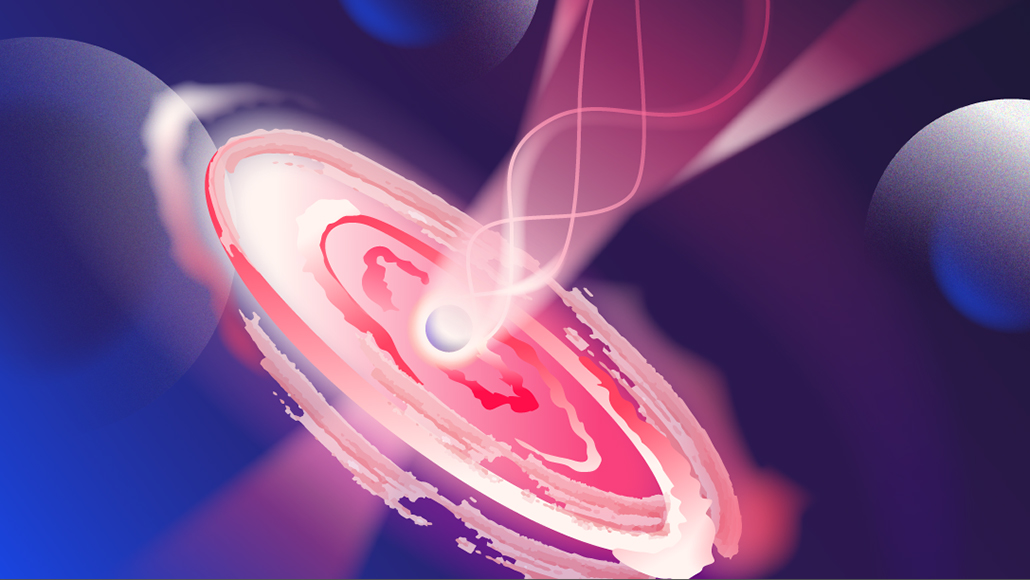
Some black holes shoot jets of plasma into space, shown in this artist’s illustration. A new analysis reveals jets that flare out like bell-bottoms.
Daria Sokol/MIPT Press Office
- More than 2 years ago
Jets of high-energy plasma shooting away from supermassive black holes resemble bell-bottom pants — starting out narrow but ending with a flare. The shape can help astrophysicists tease out how such jets are launched and reveal details of their black holes, researchers report in the July Monthly Notices of the Royal Astronomical Society.
“From studying this region where the geometric transition happens, we can understand the black hole better,” says astrophysicist Yuri Kovalev of the Lebedev Physical Institute of the Russian Academy of Sciences in Moscow.
Most galaxies in the universe host supermassive black holes at the center. Some of those black holes are actively eating a surrounding white-hot disk of gas and dust, and shooting twin jets of high-energy particles many light-years into space. Those black holes and their disks are called active galactic nuclei, or AGN, and are among the brightest objects in the cosmos. Astronomers can see the glow from many billions of light-years away.
For a long time, observations of these jets suggested they had a cone shape, with particles shooting out from the black holes in a straight-legged V. But in the past decade or so, closer looks have shown that some jets start out with a parabolic shape, meaning the sides are slightly curved.
In 2012, astrophysicists reported that a jet launched from nearby galaxy M87 — whose black hole became the first to have its picture taken in 2017 (SN: 4/10/19) — starts out parabolic and shifts to cone-shaped at a certain distance. A jet from a second AGN was spotted with a similar flare-legged shape in 2018.
Kovalev and his colleagues wondered if these two galaxies were special somehow, or if bell-bottom jets were common features of AGN. The researchers looked at published observations of 367 AGN throughout the cosmos, spanning more than 20 years. Then the team wrote a computer algorithm to search available images for changes in the jets’ shapes.
Out of that sample, just 10 jets had the shape of flared pants. But surprisingly, all of them were extremely close to Earth, within a billion light-years. “This cannot happen accidentally,” Kovalev says. He expects the other AGN jets would also show bell-bottom legs if astronomers could look with higher-resolution telescopes.
“This transition is a common effect in jets of AGN. We have discovered that this is absolutely typical,” Kovalev says.
Masanori Nakamura, who reported M87’s bell-bottom jets and is now at Japan’s National Institute of Technology in Hachinohe City, thinks that’s a reasonable conclusion. “There is growing consensus that AGN jets may follow such similar evolution,” from parabola to cone shapes, he says. Expanding the collection of known flare-legged jets “is a significant step.”
The shape shift could have to do with how jets are launched from black holes in the first place. Astrophysicists think magnetic fields in the disk around the black hole accelerate the jet particles outward. The material of intergalactic space surrounding the jet also exerts a pressure, keeping the particles bound in a tight column.
But at a certain distance from the black hole, the magnetic fields and the outside pressure stop holding such a big influence over the jet. The particles take off in straight lines, less pushed and less smooshed.
That distance is exactly where the flare appears in the jets, Kovalev and colleagues report. “It’s not a coincidence at all,” Kovalev says. Future observations with more powerful telescopes can help confirm whether more distant quasars are also stuck in the ’70s.







